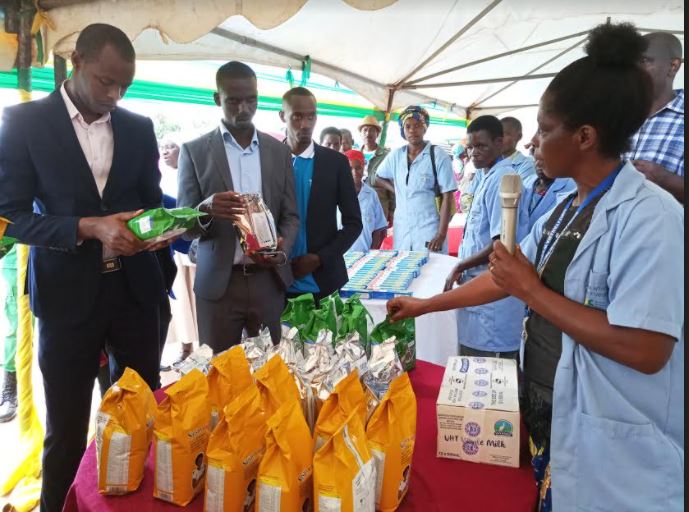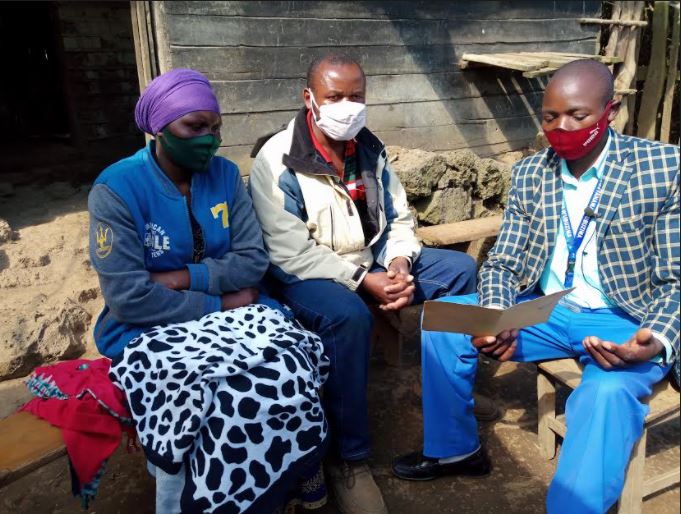
During a community dialogue in Nyaruguguru, a community health worker explains the importance of Shisha Kibondo in reducing stunting. Photo NCDA
The Government of Rwanda together with its partners have been implementing different interventions to strengthen human capital development starting in the early years of life.
Given the ambitious goal the government has committed to achieving by 2024, various projects such as scaling up early childhood development services, vitamin A supplementation, regular child growth monitoring, provision of nutritious commodities including micronutrient powder (ongera), Fortified Blended Food (Shisha Kibondo), milk, and other various health and nutrition commodities.
This regularly goes along social behavioral change communication through existing mechanisms at community level including community forums, maternal and child health week and home visits but also through radio, TV and social media all leveraged to combat malnutrition and stunting with a focus of investing in early age especially in the first 1,000 days of life after which stunting becomes largely reversible.
To better coordinate this effort, a multi-sectoral approach was adopted across government ministries and agencies, development partners, civil society, and religious organizations to promote synergy and support the healthy development of children.
One of the main goals is to accelerate the reduction of stunting in order to achieve the National Strategy for Transformation (NST 1) set at 19% by 2024. Thus, the government has increased more than three-fold investment in nutrition programs from 2015/2016 to 2017/2018 fiscal years according to a recent World Bank study on Rwanda Nutrition Expenditure and Institutional Review 2020.
In addition, this study shows that the government share of total spending on nutrition has increased from 69 percent to 83 percent in the same period. This was translated into public spending on nutrition equivalent to $36 per child under the age of 5.
In addition to this significant increasing trend, the same World Bank study notes that while not able to quantify, the contribution of parents and the community at large to improve the livelihood of young children is very crucial and will ensure sustainability. As the report highlights, the recommended public spending on nutrition-specific interventions to reach the 2025 global nutrition targets for stunting, anemia and severe wasting is estimated at US$10 per child.
Although Rwanda was still US$4 short to reach that target in 2017/2018, the government of Rwanda is confident to increase this spending significantly, by then given various ongoing investments and projects in integrated ECD services (health, nutrition, education, social protection) across the country that directly contribute to child nutrition.
The study also recognizes that it might have underestimated the spending on nutrition in Rwanda since it is difficult to estimate the contribution of some cross-cutting activities such as wages, salaries and infrastructure to nutrition across various government agencies involved.
Other activities such as community awareness through the national work umuganda and different other community forums conducted by local leaders, community health workers and other community volunteers were not converted into monetary value, thus excluded in the study, which underestimates the actual public spending to nutrition.
The child scorecard to accelerate the reduction of stunting among children
In addition, smart and well-coordinated efforts to address the complex and multisectoral issues affecting human capital development are imperative for success. It is in this perspective that the National Child development Agency in collaboration with its partners has been scaling up the child scorecard model to track health and nutrition interventions received by pregnant women and children under 2 years of age.
This model is an innovative child-centered approach contributing to other stunting reduction initiatives aiming at creating stunting free villages and households across the country, using an individual child scorecard to guide parents, community health workers and local leaders to timely identify the intervention gaps that need to be addressed at early stages before children nutrition situation deteriorates.

Child scorecard implementation in Kabagabo village, a father and mother of U 2 child discussing with a community health worker on their child growth
This innovation started in Nyabihu District in 2019 and allows quick decisions, encourages prevention and early treatment, improves good feeding practices, handwashing facilities at each household and stimulates local communities to have improved sanitary facilities and use safe drinking water.
Parents from Kabagabo Village, Cyavumba Cell, Kabatwa Sector in Nyabihu District testify that child scorecard model increased their knowledge on how to improve their children nutrition status including preparing balanced diet in their family. Uwera Claudine, a mother of one-year-old daughter, appreciates the importance of using a child scorecard.
“This child scorecard helped me a lot to understand what is stunting and what I can do to prevent it using the interventions on the scorecard. Before, I used to take my child to monthly growth monitoring sessions for screening and they used to tell me that my child is stunted, but no further guidance on how I can support my child.”
Furthermore, from the household level, the child scorecard model strengthens multi-sectoral collaboration. This is highlighted by Robert Muhirwa, Executive Secretary of Kabatwa Sector, Nyabihu District.
“The child scorecard model helps local leaders in the sector and our stakeholders to self-evaluate on nutrition indicators. I collaborate with the cell, village and Isibo leaders, community health workers and other stakeholders in the sector to analyse the root causes of the identified intervention gaps and provide support and guidance to families in need to address the gaps on time.”
After the successful pilot of the child scorecard model in Nyabihu district, the national child development agency in collaboration with different partners is scaling up this model to other districts across the country.

